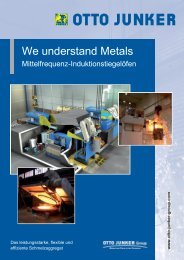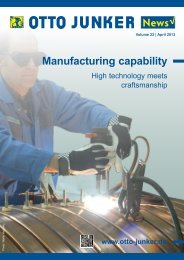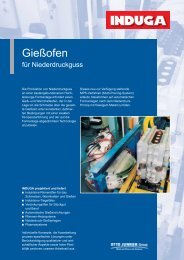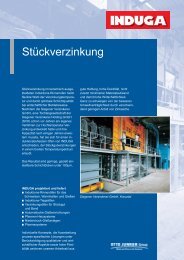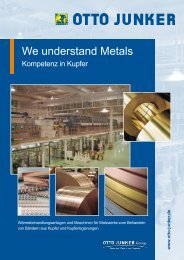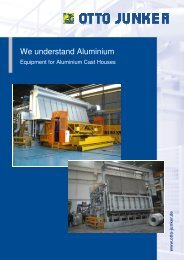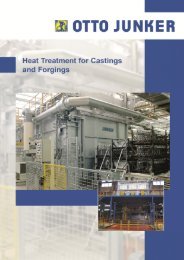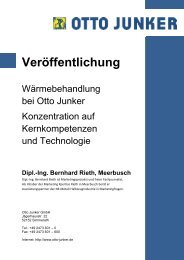SLE Pusher Furnace_E - Otto Junker GmbH
SLE Pusher Furnace_E - Otto Junker GmbH
SLE Pusher Furnace_E - Otto Junker GmbH
You also want an ePaper? Increase the reach of your titles
YUMPU automatically turns print PDFs into web optimized ePapers that Google loves.
2 / 7<br />
<strong>SLE</strong> <strong>Pusher</strong> <strong>Furnace</strong> ®<br />
Side Loaded Energy Saving <strong>Pusher</strong> <strong>Furnace</strong> ®<br />
A new generation pusher furnace for pre-heating and homogenizing<br />
aluminium slabs prior to hot rolling<br />
1. Introduction<br />
In aluminium hot-rolling, the slabs to be rolled are preheated to a 400 – 550 °C rolling<br />
temperature or else homogenized over a prolonged soak period at around 600 °C and then<br />
cooled down to this rolling temperature before entering the mill.<br />
This process is carried out mainly with the aid of pusher furnaces, pit furnaces or - in rare<br />
cases –, bogie hearth or chamber-type furnaces. For new facility projects, the pit furnace<br />
plays a lesser role than its pusher-type counterpart today since new pit furnaces are erected<br />
mainly alongside existing ones or where a broad range of diverse slab formats needs to be<br />
rolled.<br />
Example: <strong>Pusher</strong> furnace for 32-tonne slabs.<br />
The equipment type most commonly employed nowadays for pre-heating and homogenizing<br />
slabs for hot rolling is the pusher furnace, which offers a number of design-inherent benefits<br />
such as fully automatic operation, high heating and cooling rates even at high throughput<br />
levels, and the lowest technical energy consumption of all furnace types mentioned above.<br />
Its low specific gas consumption is due to the high-convection heat transfer taking place at<br />
the maximum charge density, which is considerably greater than what can be achieved in a<br />
chamber or pit-type furnace.<br />
The main part of the energy expended on the processes comes from the combustion of<br />
natural gas, LPG or other energy carriers. The amount of electric power consumed in the<br />
above processes is vastly lower, at around 6 – 8%, than the energy derived from the<br />
gaseous fuel (92 – 94 %) and shall therefore not be further considered herein.<br />
OTTO JUNKER <strong>GmbH</strong><br />
Jägerhausstraße 22<br />
52152 Simmerath<br />
Tel.: +49 2473 601-0<br />
Fax: +49 2473 601-600<br />
Internet: www.otto-junker.de<br />
Anlagenbau<br />
Gießerei



